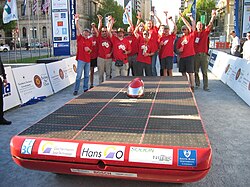HansGo!
| SolarCar | |
|---|---|

HansGo! at the finish at the World Solar Challenge 2003 |
|
| HansGo! | |
| Presentation year: | 2003 |
| Vehicle fair: | |
| Class : | |
| Body shape : | |
| Engine: |
Electric motor : 3.75 kW |
| Length: | 4999 mm |
| Width: | 1799 mm |
| Height: | 800 mm |
| Empty weight: | 252 kg |
| Production model: | none |
The solar powered electric vehicle HansGo! was developed and built in 2002 and 2003 by students of the FH Bochum (today: Hochschule Bochum) with the support of the London South Bank University at the FH Bochum. The successor model of this vehicle is the SolarWorld No. 1 HansGo! has participated in the World Solar Challenge 2003 and 2005. The first electric vehicle from Bochum University reached a top speed of over 125 km / h. HansGo is driven! of two wheel hub motors in the front wheels with a maximum power of 7.5 kW each. The unladen weight of the vehicle is around 252 kg, of which the batteries take up around 32 kg. The solar cells used are gallium arsenide solar cells with an efficiency of 25%. The output of the 6 m² solar cells on the roof is 2030 W.
Accumulators
The accumulators are 32 lithium-ion accumulators. Which were obtained from the company SAFT. A battery weight of 32 kg is available for the World Solar Challenge (as of 2003). A stored amount of energy of 4821 Wh at a nominal voltage of 104.2 V was achieved.
Solar cells
The solar cells are gallium arsenide solar cells. The maximum efficiency of a cell is 25%. In order to achieve this level of efficiency, MPPTs (Maximum Power Point Tracker) from AERL are used in the vehicle. The total electrical power of the array is approx. 2030 W.
engine
The engine is an NGM engine of the type EVC402. The permanent magnet synchronous machine has a nominal output of 3.75 kW and a maximum output of 7.5 kW. The maximum speed of the vehicle is 125 km / h.
World Solar Challenge
The vehicle was specially built for the World Solar Challenge 2003 (WSC 2003). In the race across the Australian continent (3000 km from Darwin to Adelaide) the vehicle took 5th place. It also received the Technical Innovation Award for the Bluetooth telemetry system developed at Bochum University.
The team
During the race, the team consisted of around 22 students who were also responsible for building the vehicle. In the team, individual working groups dealt with the electrics, mechanics, strategy and organization of the competition.
Individual evidence
- ↑ Bochum University: Website for HansGo!
- ↑ Bochum University of Applied Sciences: Race diary
- ↑ Press release from the Bochum University of Applied Sciences from October 28, 2003: Solar racer HansGo! receives Australian innovation award (PDF file)
- ^ WSC 2003 team , website of the Bochum University of Applied Sciences